The preservation of the collection and of the historical building is now one of the central tasks of the Styrian Armoury. A team of three restorers provides for the protection and preservation of weapons and war equipment.
Conservation
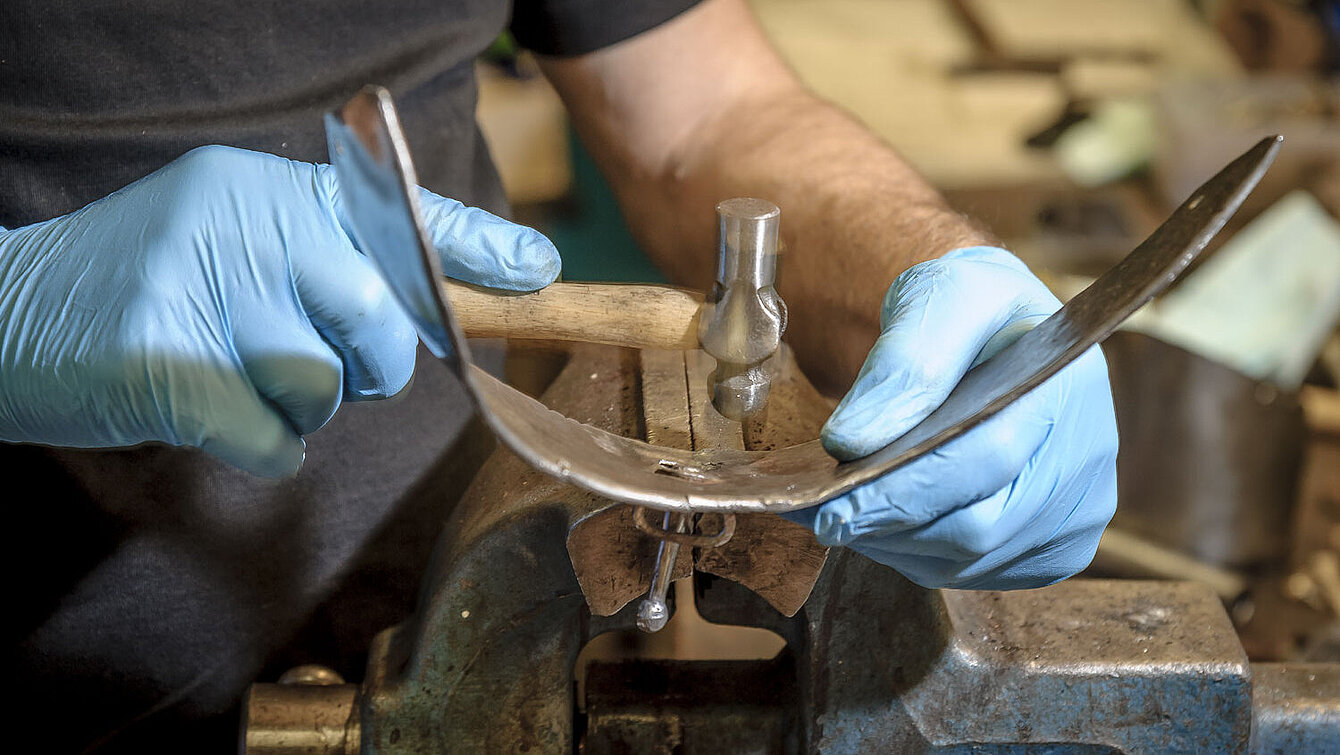

Image Credits
Conserving, examining, restoring – or: The daily work of the conservator
Bettina Habsburg-Lothringen in discussion with Thomas Storm, Thomas Köhler und Johann Weichhart
Herr Storm, as director of the workshop can you give us a brief overview of what is involved in being a conservator at an establishment such as the armoury, and how – if it is the case – conservation work here is different from working in other museums?
Thomas Storm: At the moment there are three of us conservators in the team at the armoury, and our task is to preserve the building's collection for future generations of visitors and academics. So our main task is to protect and preserve objects of cultural value. Furthermore I think it is very significant that we are in a historic building; the house itself is therefore a part of the collection and looked after alongside it by us conservators.
So what is the daily life of a conservator like? What do you do all day?
Thomas Köhler: The best-case scenario includes an inspection of the house at the beginning or otherwise at least at some time during the working day; it is only by walking through the different floors regularly and by carrying out routine checks that we are able to see any changes, in view of the thousands of items exhibited here: has a light gone out? Is something hanging at an odd angle? Is there any damage to be seen? Has an item that was removed for an exhibition been replaced? Are all windows and balconies in good order? And so on. Because of the size of the building and the number of items which we store here without the usual display cabinets found in museums, we can only keep an overview of the building and the collection by observing and checking as we walk through it. For me personally, these “visits” before the museum opens are often the most atmospheric moments of my day. As we go around, the wooden floors and display shelves groan and creak in a few areas; you can hardly hear the noise from the street as the building's history can always be felt.
When you have finished your daily walk around the building, what then happens in your workshop?
Thomas Storm: In the workshop we mainly focus on maintaining the collection and any necessary restoration works: sometimes visitors touch the objects, and in doing so create rust spots that we have to remove. For example, fluctuations in temperature cause damage to the shaft of a weapon, for example, that we then try to repair. Leather and any textile elements on the suits of armour become fragile due to old age and need to be repaired, and so on. If we take an item into the workshop, we examine its condition in the first instance and document any possible damage. Then we discuss what measures we can take and how big the job will be.
Johann Weichhart: Another area of work is preparing the exhibitions outside the armoury. In the last few years our stock has been seen in various international exhibitions. Preparing for such a project means for us conservators the professional preparation of hundreds of items from our stock, which need to be checked with regard to their transportability, their condition has to be documented, they have to be packed up and accompanied during transportation, unpacked at their destination, set up and then, later on, brought back to Graz and returned to their place in the armoury.
To a large extent, the objects in the armoury are made of metal but you have just mentioned leather, textiles and wood. I assume that each of these materials has its own requirements and reacts in different ways – to damp air and dry air, for example. How do you juggle all of that in your daily work?
Thomas Storm: You are correct that we largely deal with metal, and as conservators are also specialists in this material. Some metal parts of the armour are held together with leather straps. Then, as we mentioned before, some of the shafts of the weapons here are made of wood. In addition, there are some weapons which have textile elements and bone inlays. That definitely creates a challenge for us, and we have to monitor constantly the changes in temperature in the armoury.
Thomas Köhler: Overall it is perhaps important to bear in mind that we have no air conditioning in the armoury, as many museums have. For a very long time now we have tried to control the fluctuations in temperature and air humidity inside the building with targeted ventilation or aeration. In practice what this means today is that in summer, for example, we observe the weather conditions or react as quickly as possible to storms that come on suddenly. In those cases, we have to close the windows and balconies quickly!
I think that visitors to the armoury are interested to know how, for example, a conservator can determine the age and origin of a historical weapon.
Thomas Storm: There is, of course, a lot of specialist literature on historical weapons and we are familiar with the developments in the field of weapons technology, so that we can often say relatively quickly and unequivocally how old an object is. The material that has been used also allows us to infer the age and origin of a weapon, simply because certain materials were not yet – or not frequently, or were even no longer – in use at certain times.
Johann Weichhart: ...furthermore, it's all about the mechanics and workmanship, the shape, the visual execution and surface design – these things reflect the trends of certain times.
Thomas Storm: Yes, weapons in Europe were designed differently in each region. Lastly there are also the so-called “master's marks” made by the craftsmen; these would be engraved on the weapons' barrels or locks and they enable us nowadays to attribute an item to a particular place of production.
The history of the armoury as a weapons store creates a situation for us today in which we have to deal with swords, pistols or cannons that were produced and acquired in order to be used against people during conflict. As a museologist I can see that this fact brings a special kind of responsibility with it. How do you view this against the background of your profession? Does working with weapons have a legal dimension for you? Does working with weapons require special authorisation? Can a museum freely hoard weapons?
Thomas Storm: In Austria there is a weapons law that clearly regulates the possession of firearms for private individuals – including the minimum age of the owner, compulsory registration, safe keeping etc. Weapons that were made before 1871 are regarded as historic weapons in Austria, and the armoury's collection falls into this category.
Thomas Köhler: Alongside this legal dimension there is, of course, an ethical one. The fact that as a historical weapons store we are, in terms of content, linked to the topic of war is an important topic and a daily challenge particularly for our colleagues who present the objects and the information. I think that there is now a clear position on that front today – to use the region's history of war and our collection as a springboard and as a chance to talk about traditional images of history on the one hand, and on the other about war and violence in general and in its current form, and also to use it as a chance to enter into dialogue and to raise awareness.
What conservators bring to museums in terms of knowledge and expertise with the items is, however, very different from what a historian or cultural mediator can bring. How do you actually become a conservator, and what kind of training can you do in Austria towards this profession?
Johann Weichhart: A historian should be responsible for researching the history and origin of the pieces, the conservator for looking after and maintaining them. One possible foundation for the work here in the state armoury is a profession that works with metal, such as locksmiths, mechanical engineers or precision engineers. Through practical jobs and the further training that match them, you can then work your way into the area of restoration.
Thomas Köhler: Further ways into the armoury's workshop can be found through the relevant vocational schools or by studying within the field of restoration.
Johann Weichhart, you are the longest-serving worker in the restoration workshop. Has your job changed much in the last few decades?
Johann Weichhart: I have now been at the armoury for around 35 years. During this time we have tried a few things out machine-wise in terms of restoring our collection but we have largely stayed with the tried and tested methods. As far as the conservation work goes, we have followed another direction. I think that we are always moving between what we have learnt through experience, and what technology and research bring in terms of new methods.
Thomas Köhler: Of course we work here within a particular framework – and this is also the case with our technical possibilities. But the way I see it is that working with the objects requires experience above all else: you begin to work in the armoury and gain certain working techniques from your colleagues – for example, the specialist way to dismantle a wheellock, which is something that you rarely see in the daily life of a gunsmith. Even when you have learnt the craft, you know very little at the beginning about the mechanics of an object. Handling an object wrongly or carelessly can damage the object itself and the human body. There are expert ways of handling objects which have been tried and tested over 400 years, and which have traditionally been passed down the generations from armoury manager to armoury manager – “the basics”, to use a modern term.
I would finally like to get round to talking about the visitors. It is not always easy to bring together the interest of many thousands of people each year with the preservation of objects: it is not always easy to reconcile the museum as a place for people with the museum as an archive or as a place of preservation. With this in mind, I would finally like to ask whether you as conservators would like to give the public something extra to take away with them?
Thomas Storm: At the armoury we have the special situation whereby our objects are not exhibited under the cover of glass but rather lie freely on the display shelves or stand in the room. This tempts many visitors to touch the objects.
Thomas Köhler: Our museum is open in all areas, with very few restrictions. Of course the objects are mounted securely and stably using various means, but fundamentally they are accessible. It is really for safety reasons that we recommend visitors follow the walking tour through the different floors. Asking visitors not to touch the objects is not just about the danger of injury; one of the causes of damage to the objects is, unfortunately and increasingly, corrosion which attacks the surface of the metal not just through the humidity in the air and through sulphur oxide-atmospheric connections and which makes it “rust”, but which also arises from physical touch, which leaves sweat behind. So we ask our visitors to resist the temptation to touch any of the objects – with the exception of the display copies, which you can touch along with our guides.
Many thanks for talking to me!

Image Credits
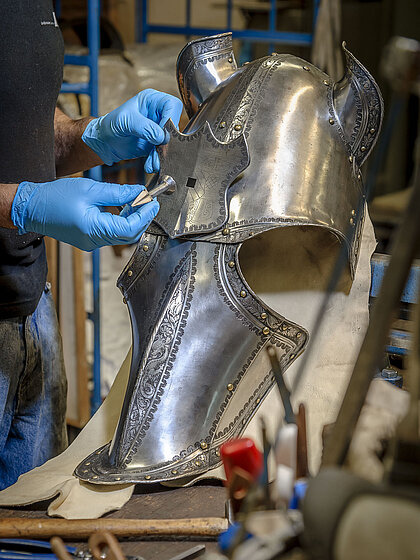
Image Credits
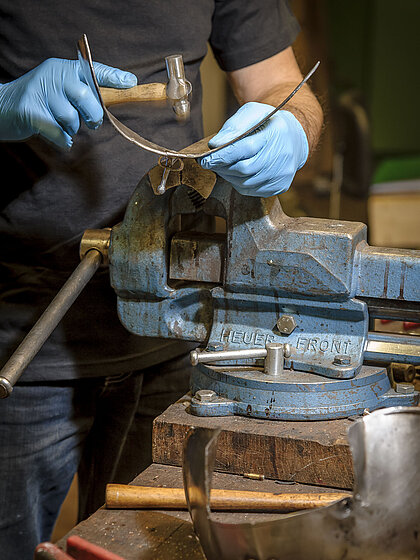
Image Credits
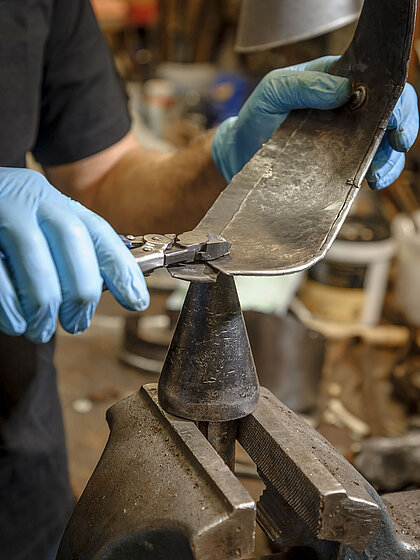
Image Credits

Image Credits
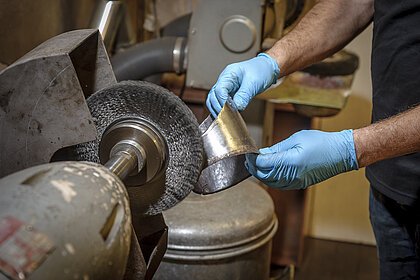
Image Credits



















